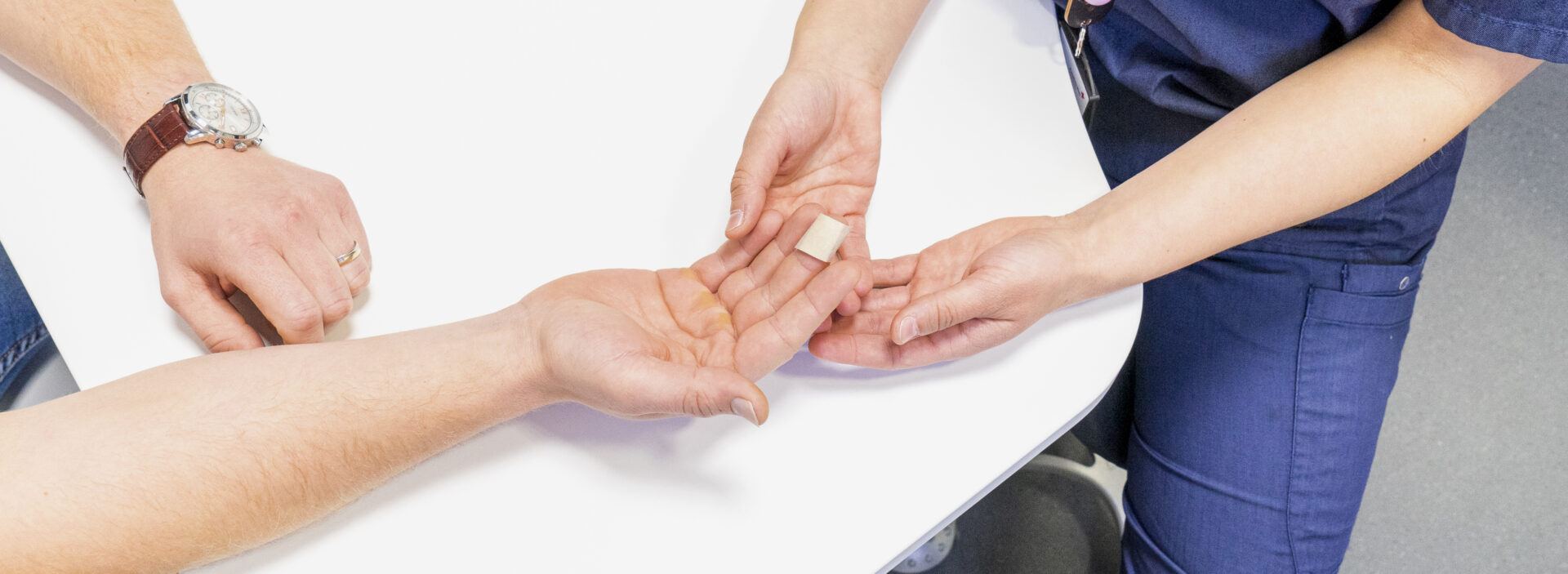What a blood donor should know about haemoglobin and iron
On this page you will find information about haemoglobin, ferritin and the prevention of iron deficiency in blood donors.

Iron is an essential building block of the body. It is needed for haemoglobin in red cells, but also in muscles and the enzymes that regulate bodily functions. The most significant function of iron relates to red blood cells: a person needs iron as a building agent for haemoglobin which is responsible for the transport of oxygen.
In the body, iron is recycled and transported. At excessive concentrations, iron is a harmful substance for the body and, therefore, the regulation of its balance is a complex and multi-stage process. Iron is stored in the liver and is also present in the bone marrow, where blood cells are produced. There is also iron in blood plasma and white blood cells.
What is haemoglobin?
About one-third of the red blood cell consists of haemoglobin (Hb). Haemoglobin is an iron-rich protein and has a key function: it transports oxygen from the lungs throughout the body.
Haemoglobin concentration measurement is one of the most commonly used laboratory tests in health care. Each person has an individual haemoglobin level.
The reference values for haemoglobin are
- 117–155 g/l for women
- 134–167 g/l for men.
In blood donation, the limit values for haemoglobin differ slightly from the reference values. Haemoglobin is measured in Finland before every blood donation and haemoglobin measurement is also required by the authorities.
Blood can be donated if the haemoglobin value is
- 125–175 g/l for women and
- 135–195 g/l for men.
The blood for measurement of the haemoglobin concentration is drawn from the fingertip. It ensures that the donor’s haemoglobin level is not too low, i.e. that they do not have anaemia, or that the haemoglobin level is not abnormally high.
Donating blood lowers the haemoglobin concentration temporarily by 10–15 g/l.
What is ferritin?
Ferritin is a stored form of iron found in the human body. Ferritin measurement is used in a more detailed study of anaemia, examination of illnesses related to iron deposition and in the measurement of iron storages. A routine measurement of ferritin values as a screening test in healthy and asymptomatic individuals is not recommended in Finland.
In the human body, iron is stored mainly in the liver. Individual differences in the amount of stored iron are big and, on average, there is a significant difference between the sexes. A man’s iron storage is threefold compared to a woman’s iron storage.
Blood donation does not have a minimum ferritin level requirement in Finland, and ferritin is not measured in connection with blood donation. If the donor’s ferritin level has been tested due to symptoms they are experiencing, and the level has been found to be too low, they cannot donate blood until the situation has been rectified. The donation could slow down the healing of the symptoms.
In studies on blood donors conducted by the Blood Service, it has been established that in Finland the ferritin levels of donors are at a good level compared to international studies, and studies found no link between ferritin levels and a person’s perceived health status.
Read more:
- Ebeling et al. (2019): Raudanpuute ilman anemiaa – miten ferritiiniarvoa tulkitaan? (Iron deficiency without anaemia – how are ferritin values interpreted?) (in Finnish only)
- Lobier et al. (2019): The effect of donation activity dwarfs the effect of lifestyle, diet and targeted iron supplementation on blood donor iron stores.
How can iron deficiency be identified?
Iron deficiency causes anaemia, that is, a decrease in the haemoglobin concentration. Anaemia may be caused by other reasons as well, but iron deficiency is by far the most common cause of anaemia. Typical symptoms of anaemia include abnormal fatigue, exhaustion, paleness and a decrease in performance.
There may be a lack of iron in the body even before anaemia develops. Iron deficiency without anaemia is a relatively common phenomenon and does not cause symptoms for everyone. For some people, iron deficiency without anaemia causes non-specific symptoms, such as fatigue or restless legs syndrome.
Where can one get iron?
In the intake of iron, the main thing is to take care of sufficient total energy intake and consume products containing iron.
In terms of iron absorption, the timing of food also plays a role and is worth paying attention to. For example, vitamin C promotes the absorption of iron, so consuming products containing vitamin C during meals improves iron intake.
Good sources of vitamin C include, for example:
- citrus fruits,
- berries and
- vegetables.
Iron absorption is impaired by calcium, as well as coffee and tea. Consuming them in moderation or separately from meals is recommended for iron absorption. Foods rich in calcium include dairy products, for example.
Almost all food contains iron, but there are differences in iron absorption. The heme iron from products of animal origin is better absorbed than iron from plant products, i.e. nonheme iron.
Good sources of heme iron include, for example:
- meat,
- fish and
- poultry.
Among plant products, iron is obtained from, for example:
- vegetables,
- legumes,
- bread and other cereal products.
How the Blood Service looks after the iron levels of blood donors
Donation intervals
The frequency of blood donations affects the haemoglobin and iron levels. The Blood Service recommends and allows different annual donation numbers for women and men precisely due the issue with iron. For the youngest women (18–25 years of age), based on our own iron research, we have guidelines on donation no more than once a year.
Iron supplements
In connection with blood donation, the Blood Service distributes iron tablets (á 50 mg) to groups of donors identified as belonging to risk groups with regard to iron deficiency (all women under 50 years of age and all those who donate blood every 4 months or more frequently). For the youngest women (18–25 years of age), we give two 20-tablet bottles of iron and one bottle to the others.
Iron supplementation helps to recover from the iron loss caused by blood donation.
Use the iron supplements as follows:
- Take one iron tablet a day or every other day.
- Use all the tablets you receive from the donation unit.
- Iron supplements are best absorbed in an empty stomach, but the tablet can also be taken with a meal.
- Vitamin C increases the absorption of iron, and milk, coffee, as well as tea weakens it. The iron tablet also contains a small amount of vitamin C.
How can the potential side effects of iron supplements be minimised?
- Use iron only every other day
- Take the iron preparation in connection with a meal or in the evening instead of morning.
If the preparation does not agree with your stomach, or the above methods are of no help, the importance of your diet as a source of iron is further emphasised. In this case, make sure that your diet includes plenty of iron sources. If you cannot use iron supplements and you are at risk of iron deficiency, for example, due to menstruation, we recommend that you do not donate blood more than once a year.

Measurement of haemoglobin
In the Blood Service, haemoglobin is measured by means of a quick test taken from the blood sample drawn from your fingertip before each donation. The Blood Service has examined the quick testing of the haemoglobin concentration, and based on the study results, the current quick test has been taken to use. It provides the result quickly and, if needed, the measurement can be double-checked by using the quick indicator and a drop of venous blood.
If the haemoglobin concentration is below the donation limit (at minimum 125 g/l for women and 135 g/l for men) or has decreased by more than 20 g/l below the blood donor’s normal level, blood cannot be donated.
Health questionnaire
Before each blood donation, an electronic health questionnaire is completed. The blood donor will be asked about their wellbeing and experience on their own health, and extensive questions about, for example, medication and ongoing examinations.
You can donate blood when you are feeling well. If you are exhausted, exceptionally tired or otherwise feeling unwell, you should not donate blood.
Research activities
Issues related to donor health are being studied as part of the Blood Service’s own research activities. In 2015–2018, Blood Service conducted an extensive FinDonor health survey and the work has since continued. Every year, we publish research results ourselves and are also involved in international research groups and publications associated with blood donation.
Based on our research findings, we have changed the recommendation on donation intervals and iron supplement distribution among young women and developed our haemoglobin measurement practices.